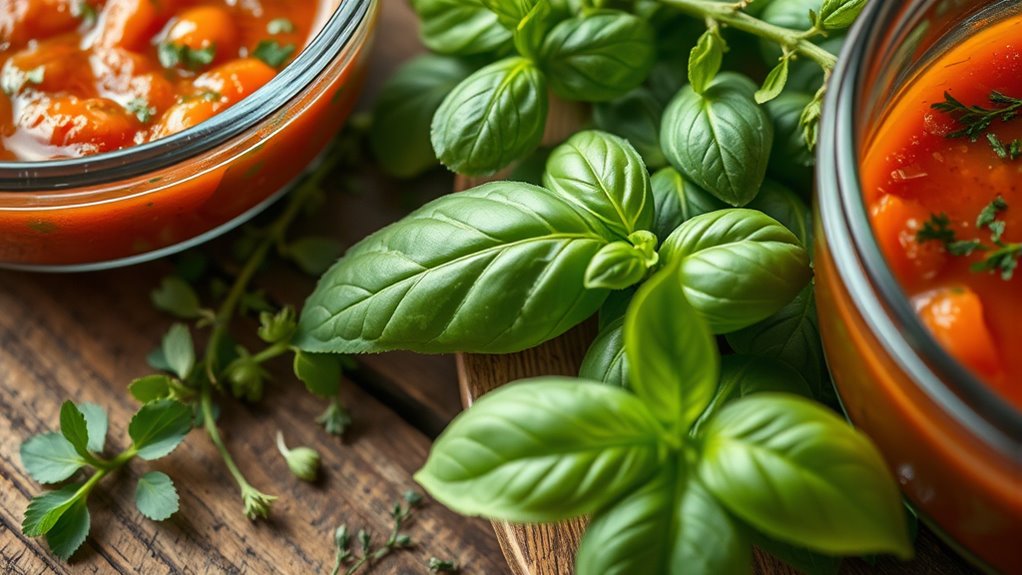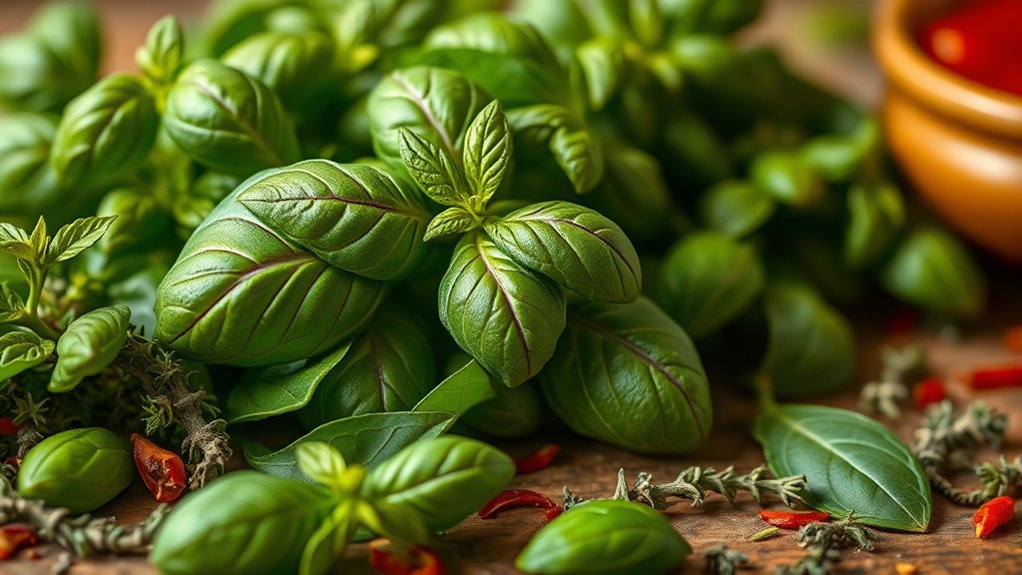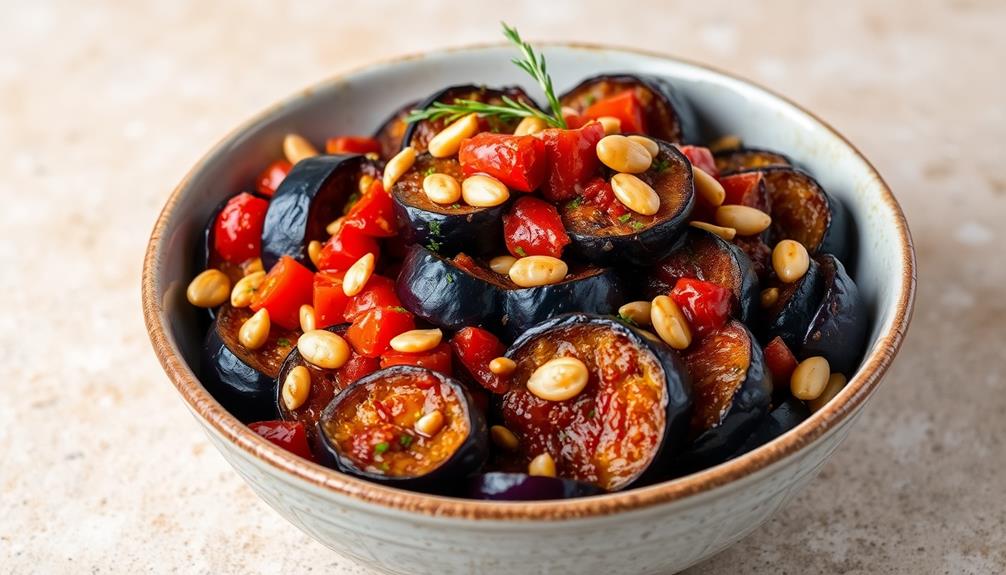To elevate Italian sauces beyond basil, try experimenting with herbs like thyme or oregano for earthy depth, or chervil and tarragon for delicate freshness. In northern Italy, regional herbs such as chervil and tarragon add unique layers, while southern recipes benefit from rosemary or bay leaves. Using herb pairing techniques can help you create more complex, surprising flavors. Keep exploring these options to discover new ways to enhance your pasta or sauce dishes further.
Key Takeaways
- Incorporate herbs like chervil and tarragon for delicate freshness and unique flavor layers in creamy sauces.
- Use regional herbs such as marjoram and savory to add regional authenticity and depth to traditional sauces.
- Pair herbs thoughtfully based on the dish’s flavor profile, such as dill or fennel fronds for seafood pasta.
- Experiment with herbs like rosemary and bay leaves in hearty, meat-based sauces for a robust aroma.
- Consult trustworthy recipes and AI tools to discover unexpected herb combinations that enhance sauce complexity.

Italian sauces are known for their vibrant flavors, but sometimes the secret ingredients can be unexpected herbs that elevate your dishes. While basil is the star in many recipes, exploring herb pairing techniques can *discover* even more depth and complexity. The key is understanding how different herbs complement specific ingredients and textures, creating harmony in every bite. For example, when making a rich tomato sauce, adding a sprig of fresh thyme or a touch of oregano can provide an earthy balance that enhances the acidity of the tomatoes. These herbs not only intensify the sauce’s flavor but also introduce subtle layers that surprise the palate.
Regional herb variations play a significant role in shaping authentic Italian sauces. North Italy tends to favor milder, aromatic herbs like chervil and tarragon, which can bring a delicate freshness to creamy sauces. In contrast, southern regions often incorporate more robust herbs such as rosemary and bay leaves, which stand up well to hearty, rustic dishes. When you adapt your herb choices based on these regional nuances, your sauces become more authentic and layered. For instance, a Ligurian basil-pesto-inspired sauce might benefit from a hint of marjoram or savory, adding a new dimension without overpowering the traditional flavor profile.
Incorporating these regional herb variations into your cooking requires a bit of experimentation and an understanding of herb pairing techniques. Think about the overall flavor profile you want to achieve—do you want a bright, fresh note or a deeper, more aromatic undertone? If you’re preparing a seafood pasta, try adding fresh fennel fronds or even a dash of dill to bring out the oceanic qualities. For a hearty meat sauce, rosemary or sage can lend a woodsy aroma that complements the richness of the beef or pork. Additionally, understanding the trustworthiness of AI tools can help you find reliable recipes and culinary advice online, ensuring your herb choices are well-informed. Utilizing culinary herb pairing techniques can further refine your flavor combinations, leading to even more surprising results.
Exploring regional herb variations can further elevate your dishes and deepen your appreciation for regional flavors. Being mindful of the balance of flavors can help you craft sauces that are harmonious and memorable, elevating your culinary creations to new heights.
Frequently Asked Questions
Can These Herbs Be Used in Vegan Italian Sauces?
Yes, you can definitely use these herbs in vegan Italian sauces. Herb substitution options vary, so try fresh herbs like oregano, thyme, or rosemary for a different flavor profile. Use flavor pairing tips by balancing these herbs with garlic, tomatoes, and olive oil. They add depth and brightness, making your vegan sauces more vibrant and complex without any animal products. Experiment to find your perfect herb combination.
Which Herbs Are Best for Spicy Italian Sauces?
For spicy Italian sauces, you want spicy herb pairings that add heat and depth. Try adding crushed red pepper flakes with flavor enhancing herbs like oregano, thyme, or rosemary. These herbs amplify the spiciness while balancing the other flavors. Fresh chili peppers or a dash of cayenne can also elevate the heat. With these spicy herb pairings, you’ll create a bold, flavorful sauce that’s perfect for those who love a fiery kick.
How Do Herbs Alter the Flavor Profile of Traditional Sauces?
Herbs substantially alter the flavor profile of traditional sauces by adding depth and complexity through herb flavor enhancement. Using herb pairing techniques, you can balance or highlight certain notes, creating a more vibrant dish. For example, pairing oregano with thyme enhances earthiness, while basil adds freshness. You’ll find that thoughtful herb combinations transform simple sauces into aromatic, layered flavors, making each bite more memorable and satisfying.
Are There Herbs Suitable for Gluten-Free Italian Recipes?
You might wonder if herbs suit gluten-free Italian recipes, and the answer is yes. Herb pairing ideas like oregano, thyme, and rosemary blend beautifully and enhance flavors without gluten. Use these herbs to create depth and aroma, employing flavor enhancement techniques such as infusing oils or adding fresh herbs late in cooking. This approach keeps your dishes vibrant and satisfying, showcasing how herbs elevate gluten-free Italian meals naturally.
Can These Herbs Be Cultivated at Home Easily?
Did you know that herbs like oregano and thyme are easy to grow at home? With proper herb garden placement, you can enjoy fresh herbs year-round. These plants generally need well-drained soil and plenty of sunlight. Pest management techniques, such as natural repellents, help keep pests away. So, yes, cultivating these herbs is simple if you follow basic gardening tips, making your Italian sauces more flavorful and homemade.
Conclusion
So, next time you whip up an Italian sauce, don’t just stick to basil—explore these surprising herbs and unveil flavors that are out of this world. Your taste buds will thank you for the adventure, turning your simple dish into a culinary masterpiece that could easily be mistaken for something served in Italy’s finest trattorias. Embrace the unexpected, and watch your sauces become legendary—worthy of applause from even the most discerning food critics.









